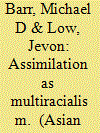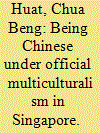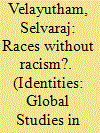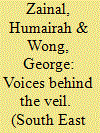|
|
|
Sort Order |
|
|
|
Items / Page
|
|
|
|
|
|
|
| Srl | Item |
| 1 |
ID:
072651


|
|
|
|
|
| Publication |
2005.
|
| Summary/Abstract |
The myths of meritocracy and multiracialism 'explain' between them both the 'fairness' of the Singapore system and the subordinate role of the non-Chinese minority races. They also purport to assure the minorities that they enjoy full status as members of the nation-building project and that their cultural and religious mores are embraced and protected within its framework. Using the Malay minority as its case study, and arguing from archival, oral, official government and secondary sources, this paper argues that the Singapore systems of meritocracy and multiracialism have not been concerned primarily with intercommunal tolerance since the 1970s, but are now programmes of assimilation of the racial minorities into a Chinese-dominated society.
|
|
|
|
|
|
|
|
|
|
|
|
|
|
|
|
| 2 |
ID:
093964


|
|
|
|
|
| Publication |
2010.
|
| Summary/Abstract |
At the time of independence, there were three visible racial groups among its newly constituted citizenry: an overwhelming majority of ethnic Chinese; regionally indigenous Malays and a small percentage of South Asians. The Cold War conditions precluded the island-state from being a Chinese majority state; constitutionally the new state was declared a multiracial nation. The three groups were reconstituted as Huaren, Malays and Indians. Multiracialism as official policy has become a means of governance of the People's Action Party single-party dominant government. Racial harmony as the public good provides the political and administrative space for the policing of racial boundaries, suppressing open discussion of racial issues. Meanwhile, Huaren culture has been progressively reduced to emphasis on filial piety as Confucianism writ small and an emergent Singaporean identity distances the local born Huaren from the 'foreign workers' that arrive daily from the People's Republic of China.
|
|
|
|
|
|
|
|
|
|
|
|
|
|
|
|
| 3 |
ID:
116302


|
|
|
|
|
| Publication |
2012.
|
| Summary/Abstract |
In the 40 years since Fiji became independent, there has been no shortage of perspectives from which to frame its development: its colonial past, its dual status as a Third World and Pacific island state, and, most pervasively perhaps, race conflict. This article focuses on another perspective: the failure of ethnic Fijian leaders to democratise their community politically and economically. Its consequences for the country have been long-standing and lie behind Fiji's developing coup culture.
|
|
|
|
|
|
|
|
|
|
|
|
|
|
|
|
| 4 |
ID:
060497


|
|
|
| 5 |
ID:
153681


|
|
|
|
|
| Summary/Abstract |
In Singapore, race has a prominent place in the city state’s national policies. Its political ideology of multiracialism proclaims racial equality and protection for minority groups from racial discrimination. However, despite official rhetoric and policies aimed at managing and integrating the different ethnic groups, some scholars have argued that institutional racism does exist in Singapore. While it is public knowledge, with few exceptions, racist provocations and experiences of racism are not publicly discussed. In recent years, the advent of social media has made it possible for Singaporeans oftentimes unwittingly to express racially derogatory remarks. This has highlighted that racism is much more deep rooted. Yet, it still remains the white elephant in the room. This paper examines the sociopolitical context that has contributed to everyday racial discrimination and calls for a public acknowledgement of racism so as to combat racist practices.
|
|
|
|
|
|
|
|
|
|
|
|
|
|
|
|
| 6 |
ID:
099302


|
|
|
|
|
| Publication |
2010.
|
| Summary/Abstract |
For the first time in American history, the 2000 United States census allowed individuals to choose more than one race. That new policy sets up our exploration of whether and how multiracialism is entering Americans' understanding and practice of race. By analyzing briefly earlier cases of racial construction, we uncover three factors important to understanding if and how intensely a feedback effect for racial classification will be generated. Using this framework, we find that multiracialism has been institutionalized in the federal government, and is moving toward institutionalization in the private sector and other governmental units. In addition, the small proportion of Americans who now define themselves as multiracial is growing absolutely and relatively, and evidence suggests a continued rise. Increasing multiracial identification is made more likely by racial mixture's growing prominence in American society-demographically, culturally, economically, and psychologically. However, the politics side of the feedback loop is complicated by the fact that identification is not identity. Traditional racial or ethnic loyalties and understandings remain strong, including among potential multiracial identifiers. Therefore, if mixed-race identification is to evolve into a multiracial identity, it may not be at the expense of existing group consciousness. Instead, we expect mixed-race identity to be contextual, fluid, and additive, so that it can be layered onto rather than substituted for traditional monoracial commitments. If the multiracial movement successfully challenges the longstanding understanding and practice of "one drop of blood" racial groups, it has the potential to change much of the politics and policy of American race relations.
|
|
|
|
|
|
|
|
|
|
|
|
|
|
|
|
| 7 |
ID:
154718


|
|
|
|
|
| Summary/Abstract |
This article critically examines the hijab debate in Singapore by drawing upon the lived experiences of Singaporean Malay-Muslim women whose daily lives are fraught with a constant negotiation between their identities as veiled women and the institutionalized constraints that impede their social mobility and voices in the public arena. Drawing upon publicly accessible data and findings from in-depth interviews with Malay-Muslim nurses, the article explores the everyday lived struggles of women working in Singapore’s public healthcare sector organizations. These struggles illustrate a decade-old public debate on the hijab. We show how these women’s narratives reflect their intersectional subjectivities, which unravel dominant state discourses on multiracialism that claim the incompatibility of the hijab with secularism. We argue that a re-positioning of the existing debate beyond its dominant association with race is crucial in overcoming the political inertia that continues to plague the hijab issue in Singapore.
|
|
|
|
|
|
|
|
|
|
|
|
|
|
|
|
|
|
|
|
|